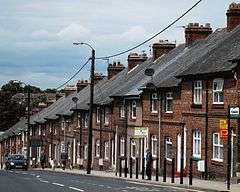Bowburn
| Bowburn | |
 The steep house lined hill is the main road through Bowburn |
|
 Bowburn |
|
| OS grid reference | NZ3038 |
|---|---|
| Unitary authority | County Durham |
| Ceremonial county | County Durham |
| Region | North East |
| Country | England |
| Sovereign state | United Kingdom |
| Police | Durham |
| Fire | County Durham and Darlington |
| Ambulance | North East |
| EU Parliament | North East England |
|
|
Coordinates: 54°44′N 1°32′W / 54.74°N 01.53°W
Bowburn is a village in County Durham, England. It is situated about 3 miles (4.8 km) to the south-east of Durham, on the A177, between Coxhoe to the south-east, and High Shincliffe to the north-west.
It is part of the Cassop-cum-Quarrington parish.
History
Originally a small farming hamlet, named after the shape of the small burn that runs through it, Bowburn's history, like that of many other villages in the region, is linked closely to coal mining. Several coal mines were sunk in the area during the 19th century but extensive development did not begin until an entirely new Bowburn Colliery began to be sunk in 1906. Bowburn therefore celebrated its 100th anniversary on 23 July 2006.
The first “Bowburn Colliery” was a shaft sunk in 1840 but failed to find workable coal.
The second Bowburn Colliery was sunk a few years later, south of there (near Park Hill), being one of several sunk in the Quarrington and Coxhoe areas. It was close to the terminus of the Durham Branch of the Clarence Railway. The pit was a small concern, worked first by Robson and Jackson and then the West Hetton Coal Company. It probably closed in about 1870.
The third and most famous Bowburn Colliery was sunk in 1906 by Bell Bros. Ltd., using the 1840 shaft as the ventilation upcast shaft (and, later, for manriding). Its first coal was drawn in 1908. It merged with Tursdale colliery in 1931 and grew to be one of the largest in the Durham coalfield, working six seams and with over 2,500 employees in the 1950s. Meanwhile the village was growing around it. Hardly anything now remains of the colliery complex which closed in July 1967. The colliery yard is now the site of the Bowburn South Industrial Estate.
The day of the annual Durham Miners' Gala (also called "the Big Meeting") used to see large unions of men marching through the village, as Bowburn was en route to Durham for some surrounding pit villages. Local residents have recently, with the help of the Heritage Lottery Fund, had two of Bowburn’s original miners’ banners restored and a new one produced to be paraded at the Gala. By September 2006, two of the restored banners were on display in Bowburn Community Centre, together with the new one (the "Centenary Banner"). This, with another new one designed by Bowburn Junior School pupils, was paraded for the first time at the 2006 Gala. Other events also celebrated the village’s centenary year, including a party and firework display in Bowburn Park, exactly 100 years after Gertrude Bell (as daughter of the Chairman of Bell Brothers) cut the first sod on 23 July 1906 to commence the sinking of the downcast shaft.
Facilities


Following the closure of the colliery and latterly the Cape Minerals Works, Bowburn declined. More recently the location of the village, near Durham City and close to the A1(M) junction 61, has meant that the village has become a prime site for new commuter housing and industrial estates.
Much of the housing in Bowburn is still relatively low cost in terraces or on post-war council estates. However there has been significant development of owner occupied housing along the eastern edge of the village, and on the old secondary school site. In recent years, a regeneration project has begun, involving the demolition of some council housing on the northern estate and the building of a mixture of housing association and private housing. As part of the regeneration project, the park has been upgraded, with new football fields, an outdoor gym and an excellent children’s play area, and significant improvements to such community facilities as Bowburn Community Centre and the DJ Evans Youth Club (aka Bowburn Youth Project).
One of Bowburn's claims to fame was its parish church, Christ the King, built between 1963 and 1978.[1][2] It had a detached spire described locally as 'The Rocket' standing alongside the main church building, which featured a spiked dome roof which led some to call it "The Pineapple Church". The church ceased to be used for public worship due to its poor condition and was demolished in June 2007, while the adjacent spire fell over due to gales on 3 October 2009.[3] In May 2008 construction of a new church building began on the site, completed in Autumn 2008.[4]
Bowburn has its own Junior and Infant & Nursery schools. Secondary pupils attend school outside the village, mostly at Durham Johnston Comprehensive School in Durham City.
Notable people
- Dick Witham, professional footballer
- Craig Thompson, CPS Advisor
References
- ↑ "Christ the King". CommuniGate. Retrieved 2008-05-19.
- ↑ "Bowburn – a short history". Retrieved 2008-05-19.
- ↑ "Rocket City No More" (PDF), Bowburn Interchange, no. 53, p. Page 6, December 2009
- ↑ "First brick laid for Pineapple Church replacement". Durham Times. 2008-04-29. Retrieved 2008-05-19.
External links
| Wikimedia Commons has media related to Bowburn. |